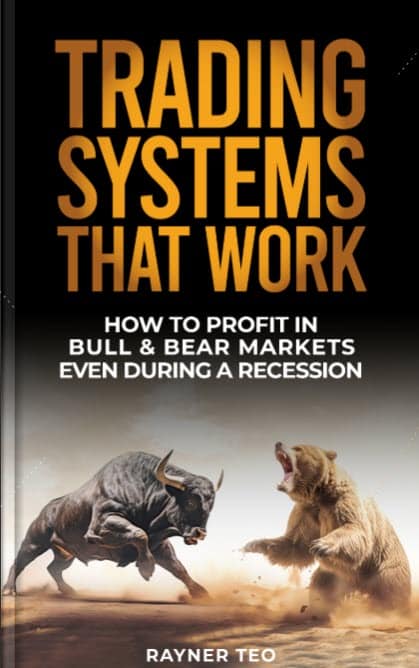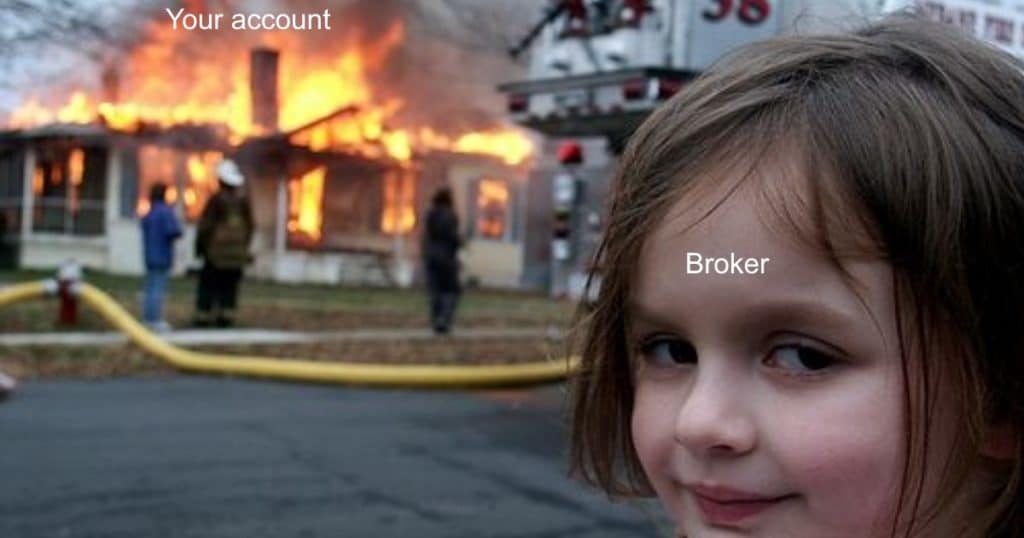CFD trading is for retail traders.
You get access to markets usually reserved for institutional traders and you have a wide variety of markets to trade from.
But here’s the thing:
Just because you have more opportunities doesn’t mean you’ll make more money.
Because when it comes to CFD trading, you must open your eyes and know what you’re dealing with.
So in today’s post, I’m going all in on CFD trading (the good, the bad, and the ugly).
You’ll discover:
- What is CFD trading and how does it work
- The benefits of CFD trading
- The risks of CFD trading (this is important)
- The cost of CFD trading you’re probably unaware of
- How much money do you need to start CFD trading?
- How to find a reliable CFD broker so can sleep soundly at night
- Is CFD trading for you?
Are you ready to dive into this comprehensive CFD trading guide?
Let’s get started now…
CFD for beginners: What is it and how does it work?
CFD stands for Contract for Difference and it allows you to buy/sell financial instruments without owning the underlying asset.
For example:
Instead of buying Apple shares, you can buy the CFD on Apple.
You’re probably wondering:
“Why would I want to do that?”
You’ll discover the benefits of CFD trading later, but first…
To do so, you must have a CFD broker and here’s how they operate…
How a CFD broker works
Most CFD providers are the market maker.
This means they create a market by taking the opposite side of your trade.
You might be thinking:
“Isn’t this unethical?”
Nope.
It’s just their business model.
Here’s why…
Most retail traders buy/sell in small quantities, and it’s not large enough to be traded in the real market.
Thus, a Market Maker (MM) broker fills this demand by creating a synthetic market for smaller traders.
Moving on…
The benefits of CFD trading you’re probably unaware of
Unlike stock trading, CFD offers a number of benefits you can’t get elsewhere.
For example…
You can short a stock
Here’s the thing:
It’s difficult to short a stock outright due to regulations.
But with CFD, you can do it easily.
This means you can hedge your positions in bad times and even profit from the market collapse.
You don’t need huge trading capital
CFD is a leveraged instrument.
This means you can control a larger position size with small trading capital.
For example:
If a stock requires 10% margin and you have $1000 trading account, you can buy up to $10,000 worth of stock.
Note: Leverage is a double-edged sword. The returns are higher but so is the risk.
You’ve got access to many markets
CFD trading is a convenient one-stop shop for you.
Because you can access markets like…
- Indices
- Bonds
- Agriculture
- Commodities
- Precious metals
- Cryptocurrencies
Yup.
All these different markets in one trading account.
How cool is that?
But wait, before you get started in CFD trading, you must know the risks that come with it…
CFD trading risks (this is important)
Compared to stocks, CFDs are riskier because it’s a leveraged instrument.
And here’s what you must know:
- Counterparty risk
- Risk of losing everything and more
- Risk of margin top-up
- Risk of getting stopped out (prematurely)
Let me explain…
Counterparty risk
Unlike stocks which are traded on an exchange, CFDs are traded against the broker.
This means if your broker goes under, everything goes along with it.
You don’t get back your money, your stocks, or anything.
Now I don’t want to be a fear monger, but the possibility is there, albeit slim if you know how to find a good broker (more on that later).
Risk of losing everything and more
Your broker is not stupid.
It requires you to put up the margin to cover your potential losses.
However, there are times the market moves too fast and you lose all your capital — and more.
If that happens, you must repay back what you owe to your broker.
Note: This applies not only to CFD trading but to all leveraged products.
Risk of margin top up
Let’s say…
You bought $10,000 worth of Crude Oil at a margin of 20%. So, you need at least $2,000 in your CFD account.
But during volatile periods, your broker might raise the margin to 40%.
This means you must inject more capital to hold the $10,000 position.
If not, your position will be closed out partially or fully (to meet the margin requirements).
Risk of getting stopped out (prematurely)
There might be price discrepancy when CFD trading, especially if your broker is a market maker.
For example:
The stock exchange might show $100 per share for Apple.
But the CFD broker would show $101 instead.
This means you might get stopped out on trades which wouldn’t be the case if it’s traded on an exchange.
Moving on:
You’ll discover the costs of CFD trading you’re probably not aware of.
Read on…
The true cost of CFD trading you’re unaware of
These are the costs of CFD trading:
- Commission
- Spread
- Holding costs
- Market data
I’ll explain…
Commission
This is a fixed transaction cost that you have to pay for opening and/or closing your trade.
It’s usually a percentage of your trade or a minimum amount of money, perhaps $10 or $20.
Direct Market Access (DMA) CFD brokers tend to charge a slightly higher commission rate than Market Maker (MM) CFD brokers.
Spread
The spread is the difference between the bid and ask price — and that’s a cost.
For example, Apple has an ask price of $100 and a bid price of $99.
This means if you want to buy Apple right now, it cost you $100.
And if you want to sell it right now, you’ll get $99.
That’s a spread of $1 — which is a cost to you.
Pro Tip: Stay away from low liquidity markets as the spread tends to be large.
Holding costs
This is a financing charge to your account for each day you hold a position.
Here’s how it works…
Let’s say you $1,000 in your account and you borrow $9,000 from your broker so you can buy $10,000 worth of stock.
Interest is charged on the $9,000 you borrowed.
And the interest depends on 2 things…
- The financing rate
- The holding period
If you want to know the exact cost, go check with your CFD broker.
Market data fees
You’re charged a monthly fee for accessing price data (especially for international markets).
But if you trade often, your broker could waive the fee.
How much money do you need to start CFD trading?
One important CFD trading tips I recommend is that you start with a minimum of $20,000.
Here’s why…
Trading fees are about $20 per trade (including buy and sell).
If you think about it…
Your transaction cost is about 0.1% on every trade (20/20,000).
So, if you take 50 trades per year, you’re looking at a total transaction cost of 5% (0.01 * 50) a year.
This means if you want to breakeven, you must earn 5% a year.
And what if your account is smaller than $20,000?
It gets worse.
On a $10,000 account, you need 10% to breakeven.
On a $5000 account, you need 20% to breakeven.
On a $2000 account, you need 50% to breakeven.
See my point?
So if you want to give yourself the best chance of success, you must have a minimum account size of $20,000 (or more).
How to find a reliable CFD broker so can sleep soundly at night
I don’t want to openly recommend any brokers because I’ve no idea what goes on behind the scenes.
And I don’t want you to lose your hard-earned money because I recommended the wrong thing.
Still, here are CFD trading tips to consider when choosing a CFD broker:
- Is it regulated?
- Is the support service good?
- Is withdrawal easy?
- Does it have the platform you want?
- Does it have the markets you want?
If you want more details on it, go read How to Choose a Good Broker So You Don’t Get Scammed.
And now, the most important question to ask yourself in this CFD trading guide…
Is CFD trading for you?
Here’s the deal:
CFD trading is not for you if…
You’re a long-term investor
Most investors using CFD trading strategies have a holding period of years.
But remember, CFD incurs a holding cost every day, and this eats into your return.
And worse:
If your CFD trade turns out to be a bummer, you suffer even more losses.
You’re a newbie
CFD is a leveraged instrument and you could lose more than your deposit.
So for new traders, I recommend studying risk management first before anything else.
CFD trading is for you if…
You want to hedge your portfolio
You can take on the opposite side of your trades and thereby reduce the volatility of your portfolio.
You want to short a stock
Unlike stocks, using CFD trading strategies on a CFD broker allows you to short stocks with little to no restriction.
You want to trade a variety of markets
This is useful if you want to trade different types of markets like Futures, Forex, Stocks, etc.
Conclusion
In today’s article, you’ve learned:
- CFD trading allows you to trade the markets without owning the underlying asset
- CFD trading allows you to short a stock and access different markets (without huge capital)
- The cost of CFD trading are commission, spread, holding costs and market data fees
- I recommend starting a CFD account of least $20,000 with a CFD broker so your commission doesn’t “eat” a huge chunk of your returns
- CFD trading is not for long-term investors and newbies
Now over to you…
What’s your take on CFD trading?
Are you currently using CFD trading strategies or strategies that require CFD brokers to execute?
Leave a comment below and share your thoughts with me.





I’m using Tradenet 6k account they give you $120,000 to trade with, but it seems like my orders are being manipulated so they can make money from the market. Honestly if I get to choose again I wouldn’t throw away that money.
Can you explain to me what the term ” drawdown” means. I have a £5000 account and recently got stopped out because of my drawdown. I’ve no idea what they meant.
Thanks
If you don’t know what is a “drawdown” STOP trading and learn a fair bit more. You will lose ALL your money!
If you have an account of 100k and it drops down to 80k, it’s a drawdown of 20%.
Your drawdown is calculated from the peak of your equity to the lows (the percentage decline).
Good 1, I love it. Will consider thus investment in future
Cheers Joseph
But what if you dont use the leverage while trading and do not trade the markets for which the broker charges fees. For example I found a broker that charges a 0.08% fee ONLY on CFD’s stocks and ETF’s all the other markets are commission free. Would you still recommend 20k as a starting capital?
Hey John
You might want to calculate the average number of trades you take per year and see how much % of transaction cost eats into your returns.
Hi,
thanks for all the information you make available for free here.
1. With a budget of 2000$ is it best to go for Micro account or will a Standard one work too?
Risking max. 1% per trade would give 20$ for StopLoss and the Lot size could be choosen accordingly (eg. 0.04).
2. Which account type is better, pro using commisions and low spread or Standard using no commissions at all and slightly wider spreads?
I suggest going with a micro account.
To have the option of wider stoploss right? This is for Swing Trading btw.
Thanks Rayner for invaluable information you have written in this article that we get for free.
God bless you
Cheers
Hi Rayner
Why is the transaction cost calculated base on account size and not position size? Your transaction cost is about 0.1% on every trade (20/20,000). We do not necessarily used up all the fund in the transactions.
Yes, that could work as well, it depends on how your broker charges commission.